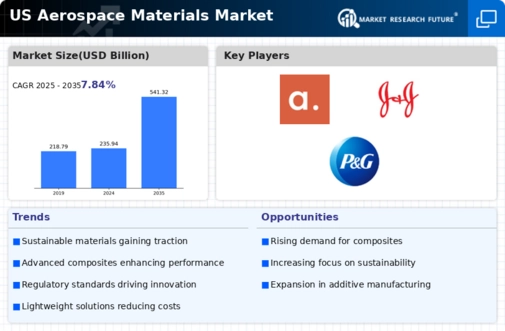Increased Defense Spending
The aerospace materials market is significantly influenced by increased defense spending in the United States. With the U.S. government allocating over $700 billion for defense in 2025, there is a heightened demand for advanced materials in military aircraft and aerospace applications. This investment is expected to bolster the development of lightweight and durable materials that can withstand extreme conditions. Additionally, the focus on enhancing the capabilities of military aircraft, such as stealth technology and improved fuel efficiency, is likely to drive innovation in the aerospace materials market. As a result, manufacturers are expected to prioritize the development of high-performance materials that meet stringent military specifications.
Emerging Markets and Globalization
The aerospace materials market is witnessing a shift due to the emergence of new markets and globalization. As countries like India and China invest in their aerospace industries, there is an increasing demand for high-quality materials. This trend is likely to create opportunities for U.S. manufacturers to expand their reach and supply advanced materials to international markets. Additionally, globalization facilitates collaboration between companies, leading to the sharing of technology and expertise in material development. This interconnectedness may drive innovation in the aerospace materials market, as manufacturers seek to meet the diverse needs of a global customer base.
Growing Demand for Commercial Aviation
The aerospace materials market is benefiting from the growing demand for commercial aviation, which is projected to expand significantly in the coming years. With an expected increase in air travel by 4.5% annually, airlines are investing in new aircraft to accommodate this growth. This trend is likely to drive the demand for advanced materials that enhance fuel efficiency and reduce operational costs. For instance, the use of lightweight composites in aircraft construction can lead to a reduction in fuel consumption by up to 20%. Consequently, manufacturers in the aerospace materials market are focusing on developing innovative solutions that cater to the evolving needs of the commercial aviation sector.
Regulatory Compliance and Safety Standards
The aerospace materials market is heavily influenced by stringent regulatory compliance and safety standards imposed by aviation authorities. In the U.S., the Federal Aviation Administration (FAA) mandates rigorous testing and certification processes for materials used in aircraft manufacturing. This regulatory environment drives manufacturers to invest in research and development to ensure their materials meet safety and performance criteria. As a result, there is a growing emphasis on developing materials that not only comply with regulations but also enhance the overall safety and reliability of aircraft. This focus on compliance is likely to propel the aerospace materials market as companies strive to innovate while adhering to safety standards.
Technological Advancements in Aerospace Materials
The aerospace materials market is experiencing a surge in technological advancements that enhance material performance and reduce weight. Innovations in composite materials, such as carbon fiber reinforced polymers, are becoming increasingly prevalent. These materials offer superior strength-to-weight ratios, which are crucial for improving fuel efficiency in aircraft. The market for advanced composites is projected to reach approximately $30 billion by 2026, indicating a robust growth trajectory. Furthermore, the integration of nanotechnology in material science is enabling the development of materials with enhanced thermal and electrical properties. This trend is likely to drive the aerospace materials market as manufacturers seek to optimize aircraft design and performance.

















Leave a Comment